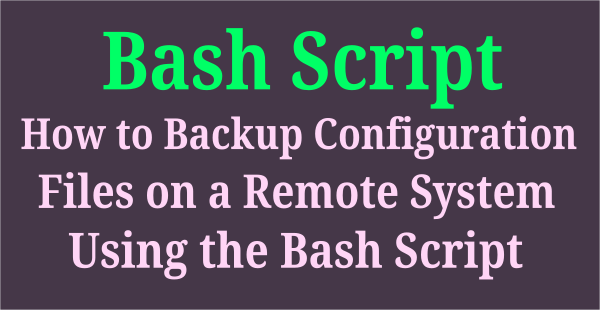Everyone knows user information was residing in /etc/passwd file.
It’s a text file that contains the essential information about each user.When we create a new user, the new user details will be appended into this file.
The /etc/passwd file contains each user essential information as a single line with seven fields.
Each line in /etc/passwd represents a single user. This file keep the user’s information in three parts.
Part-1:root user informationPart-2:system-defined accounts informationPart-3:Real user information
Suggested Read :
(#) How To Check User Created Date On Linux
(#) How To Check Which Groups A User Belongs To On Linux
(#) How To Force User To Change Password On Next Login In Linux
The first part is the root account, which is administrator account has complete power over every aspect of the system.
The second part is followed by system-defined groups and accounts that are required for proper installation and update of system software.
The third part at the end represent real people who use the system.
While creating a new users the below four files will be modified.
/etc/passwd:User details will be updated in this file./etc/shadow:User password info will be updated in this file./etc/group:Group details will be updated of the new user in this file./etc/gshadow:Group password info will be updated of the new user in the file.
Method-1: Using /etc/passwd file
Use any of the file manipulation command such as cat, more, less, etc to print the list of users were created on your Linux system.
The /etc/passwd is a text file that contains each user information, which is necessary to login Linux system. It maintain useful information about users such as username, password, user ID, group ID, user ID info, home directory and shell.
The /etc/passwd file contain every user details as a single line with seven fields as described below, each fields separated by colon “:”
# cat /etc/passwd root:x:0:0:root:/root:/bin/bash bin:x:1:1:bin:/bin:/sbin/nologin daemon:x:2:2:daemon:/sbin:/sbin/nologin adm:x:3:4:adm:/var/adm:/sbin/nologin lp:x:4:7:lp:/var/spool/lpd:/sbin/nologin sync:x:5:0:sync:/sbin:/bin/sync shutdown:x:6:0:shutdown:/sbin:/sbin/shutdown halt:x:7:0:halt:/sbin:/sbin/halt mail:x:8:12:mail:/var/spool/mail:/sbin/nologin ftp:x:14:50:FTP User:/var/ftp:/sbin/nologin postfix:x:89:89::/var/spool/postfix:/sbin/nologin sshd:x:74:74:Privilege-separated SSH:/var/empty/sshd:/sbin/nologin tcpdump:x:72:72::/:/sbin/nologin 2gadmin:x:500:10::/home/viadmin:/bin/bash apache:x:48:48:Apache:/var/www:/sbin/nologin zabbix:x:498:499:Zabbix Monitoring System:/var/lib/zabbix:/sbin/nologin mysql:x:497:502::/home/mysql:/bin/bash zend:x:502:503::/u01/zend/zend/gui/lighttpd:/sbin/nologin rpc:x:32:32:Rpcbind Daemon:/var/cache/rpcbind:/sbin/nologin 2daygeek:x:503:504::/home/2daygeek:/bin/bash named:x:25:25:Named:/var/named:/sbin/nologin mageshm:x:506:507:2g Admin - Magesh M:/home/mageshm:/bin/bash
Below are the detailed information about seven fields.
Username (magesh):Username of created user. Characters length should be between 1 to 32.Password (x):It indicates that encrypted password is stored at /etc/shadow file.User ID (UID-506):It indicates the user ID (UID) each user should be contain unique UID. UID (0-Zero) is reserved for root, UID (1-99) reserved for system users and UID (100-999) reserved for system accounts/groupsGroup ID (GID-507):It indicates the group ID (GID) each group should be contain unique GID is stored at /etc/group file.User ID Info (2g Admin - Magesh M):It indicates the command field. This field can be used to describe the user information.Home Directory (/home/mageshm):It indicates the user home directory.shell (/bin/bash):It indicates the user’s bash shell.
You can use the awk or cut command to print only the user names list on your Linux system. Both are showing the same results.
# awk -F':' '{ print $1}' /etc/passwd
or
# cut -d: -f1 /etc/passwd
root
bin
daemon
adm
lp
sync
shutdown
halt
mail
ftp
postfix
sshd
tcpdump
2gadmin
apache
zabbix
mysql
zend
rpc
2daygeek
named
mageshm
Method-2: Using getent Command
The getent command displays entries from databases supported by the Name Service Switch libraries, which are configured in /etc/nsswitch.conf.
getent command shows user details similar to /etc/passwd file, it shows every user details as a single line with seven fields.
# getent passwd root:x:0:0:root:/root:/bin/bash bin:x:1:1:bin:/bin:/sbin/nologin daemon:x:2:2:daemon:/sbin:/sbin/nologin adm:x:3:4:adm:/var/adm:/sbin/nologin lp:x:4:7:lp:/var/spool/lpd:/sbin/nologin sync:x:5:0:sync:/sbin:/bin/sync shutdown:x:6:0:shutdown:/sbin:/sbin/shutdown halt:x:7:0:halt:/sbin:/sbin/halt mail:x:8:12:mail:/var/spool/mail:/sbin/nologin ftp:x:14:50:FTP User:/var/ftp:/sbin/nologin postfix:x:89:89::/var/spool/postfix:/sbin/nologin sshd:x:74:74:Privilege-separated SSH:/var/empty/sshd:/sbin/nologin tcpdump:x:72:72::/:/sbin/nologin 2gadmin:x:500:10::/home/viadmin:/bin/bash apache:x:48:48:Apache:/var/www:/sbin/nologin zabbix:x:498:499:Zabbix Monitoring System:/var/lib/zabbix:/sbin/nologin mysql:x:497:502::/home/mysql:/bin/bash zend:x:502:503::/u01/zend/zend/gui/lighttpd:/sbin/nologin rpc:x:32:32:Rpcbind Daemon:/var/cache/rpcbind:/sbin/nologin 2daygeek:x:503:504::/home/2daygeek:/bin/bash named:x:25:25:Named:/var/named:/sbin/nologin mageshm:x:506:507:2g Admin - Magesh M:/home/mageshm:/bin/bash
Below are the detailed information about seven fields.
Username (magesh):Username of created user. Characters length should be between 1 to 32.Password (x):It indicates that encrypted password is stored at /etc/shadow file.User ID (UID-506):It indicates the user ID (UID) each user should be contain unique UID. UID (0-Zero) is reserved for root, UID (1-99) reserved for system users and UID (100-999) reserved for system accounts/groupsGroup ID (GID-507):It indicates the group ID (GID) each group should be contain unique GID is stored at /etc/group file.User ID Info (2g Admin - Magesh M):It indicates the command field. This field can be used to describe the user information.Home Directory (/home/mageshm):It indicates the user home directory.shell (/bin/bash):It indicates the user’s bash shell.
You can use the awk or cut command to print only the user names list on your Linux system. Both are showing the same results.
# getent passwd | awk -F':' '{ print $1}'
or
# getent passwd | cut -d: -f1
root
bin
daemon
adm
lp
sync
shutdown
halt
mail
ftp
postfix
sshd
tcpdump
2gadmin
apache
zabbix
mysql
zend
rpc
2daygeek
named
mageshm
Method-3: Using compgen Command
compgen is bash built-in command and it will show all available commands, aliases, and functions for you.
# compgen -u root bin daemon adm lp sync shutdown halt mail ftp postfix sshd tcpdump 2gadmin apache zabbix mysql zend rpc 2daygeek named mageshm
Please comment your inputs into our comment section, so based on that we can improve our blog and make effective article. So, stay tune with us.



